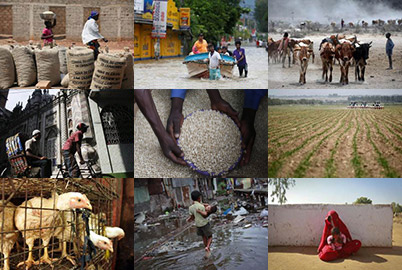A Sri Lankan woman hold candles at a tsunami victim's grave in Manalkadu village. REUTERS
In a year of disasters, Christian Aid's international director, Paul Valentin, counts the cost of the world's failure to recognise that prevention is better than cure.The year 2005 will be remembered as a year of disasters.
Barely had we grasped the full magnitude of the Boxing Day tsunami before other disasters announced themselves: hunger in Niger, Zimbabwe and Malawi; hurricanes in Central America and New Orleans; the shattered mountainsides of Kashmir, where 87,000 people died.
And then there were the ongoing crises: Sudan, the Democratic Republic of the Congo, Uganda and Iraq, to name just a few.
Invariably the poorest people suffer most during disasters. They live in the most precarious places, their ramshackle homes perched on riverbanks or floodplains and liable to be swept away; they have the fewest resources to fall back on; and they do not ' as the poor of New Orleans discovered to their terrible cost ' have the means to move to safer places.
Aid agencies have felt unprecedented pressure this year to respond to these humanitarian disasters. At Christian Aid we have helped half a million people in the aftermath of the tsunami, and many tens of thousands more: from the camps of Darfur, where people fled as their homes were torched, to the victims of the storms of Central America. But what have we learned from all this activity, in this year of disasters?
There are, of course, lessons about the timeliness of aid and the quality of response. But there are other, more profound, lessons. The first is that local people's ability to face disaster ' how prepared they are ' can make a vital difference. The second is so obvious that even mentioning it may feel trite: prevention is better than cure.
In virtually all disasters, wherever they happen, local people are the first to respond. Specialist relief and rescue operations may deserve praise for their often heroic efforts. But it is local people, with basic equipment and often using their bare hands, who rescue the greatest numbers.
The stronger the local communities and their organisations, the better the chance of responding in a timely and effective way that saves lives.
Local organisations in south India and on the east coast of Sri Lanka had community kitchens already up and running by the evening of Boxing Day. In Bangladesh, Christian Aid partners were among the many local organisations that built cyclone shelters after a cyclone killed 140,000 people in 1991. Six years later a stronger cyclone killed just 100 people, partly because communities had somewhere to shelter from the storm.
School flattenedCommunities with a basic understanding of disasters are actors in their own recovery, instead of passive recipients of other people's generosity.
Knowing what to do, identifying the vulnerable, organising records of survivors, being trained in first-aid and understanding the needs of the most vulnerable members of the community ' all these go a long way towards bringing order to post-disaster chaos and helping people take charge of their own future.
What's more, responding through well-prepared local groups is many times cheaper than flying in foreign experts and their equipment. While they have a vital role to play, external aid agencies and donors should remember that they can only enable and facilitate; local people have the right to be in the driving seat of their own recovery.
The second lesson is an old one: prevention is better than cure. We cannot prevent natural disasters from happening. But we can prepare for them. At just one school in Kashmir, 500 boys died when their school building collapsed on top of them. Do we dare calculate how many children's lives could have been saved if school buildings in Kashmir had been built to withstand earthquakes?
In south Asia the difference in cost between constructing an earthquake-proof rural primary school and a non-earthquake-proof one is a mere '500 ' '1 ($1.70) for each of the boys who died in Kashmir, crushed beneath the roof and walls of their school.
There is finally talk of building an Indian Ocean tsunami warning system similar to the one that exists in the Pacific Ocean. This is an important and relatively simple solution at inter-governmental level. In Japan, it works so well that warnings of a possible tsunami appear on people's television screens within 30 seconds of a major earthquake.
But even the best systems in the world will not save lives if not matched by local-level warning systems: linking the tsunami warning system to mobile phone networks, for example.
We need to educate local communities about what to do when disaster strikes ' arming them with FM radios, bicycles, whistles and megaphones so they can sound the alarm. It's not glamorous, it's not up for debate at the U.N., but without these simple methods the Indian Ocean early warning system will be the hi-tech icing without the low-tech cake.
Over the past few years we have seen a marked rise in the number of emergencies, and climate change is a contributory factor. The increased unpredictability of weather patterns, resulting in both drought and flooding, and the increased intensity of cyclones force us to review our response. While we have to address the causes of climate change, we also have to invest more in helping people living in the areas likely to be hardest hit to be prepared. After disasters, we must make sure that we rebuild better.
This is no piece of development jargon, but an urgent, practical matter. In the Indian Ocean, the Sumatra fault may rip apart again ' not once, says a leading geophysicist who described the faultline as an 'elastic band ready to snap', but twice. We know that disaster will face us again. This time, we can be prepared.
Any views expressed in this article are those of the author and not of Reuters.Our Standards: The Thomson Reuters Trust Principles.

